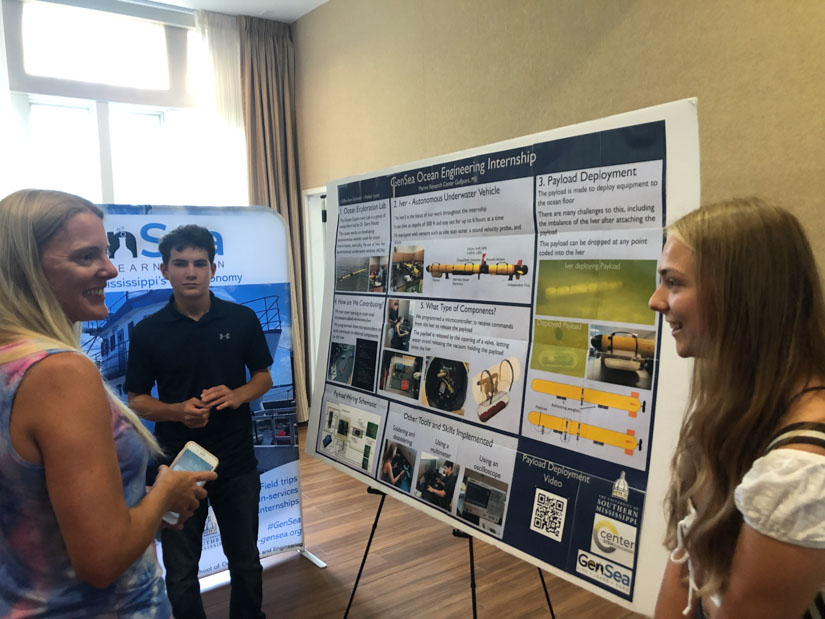Gulf Coast High School Students Learn About Blue Economy Jobs Through USM Internship Program
Thu, 07/21/2022 - 10:11am | By: Van Arnold

Marine biologist Dr. Kim de Mutsert, left, questions Walker Lyons of Vancleave High School and Sallie Ann Schmidt of Ocean Springs High School about their experiences working on an autonomous underwater vehicle during their ocean engineering internship. (Photo by Tara Skelton).
Fifteen high school students from across the Gulf Coast enjoyed a first-hand, real-world look at potential blue economy jobs earlier this summer as part of a GenSea internship program sponsored by The University of Southern Mississippi (USM).
The internships, housed across USM’s coastal operations, immerse students in fields such as hydrography/ocean floor mapping, ocean engineering, computer modeling, marine biology and aquaculture.
Tara Skelton, GenSea Director of Communications & Curriculum, notes that the internships are part of a larger strategy to introduce students on the Coast to technical jobs in the blue economy by exposing them to careers in marine science and ocean engineering that they might not have been aware of previously through the GenSea program.
“In addition to hosting these internships, GenSea conducts field trips and teacher training with the same goal: combating the brain drain in Mississippi by letting smart kids know that smart jobs are available for them right here at home,” said Skelton. “An equally important goal of the program is to introduce USM’s School of Ocean Science and Engineering as the best place to learn the skills to compete in these industries.”
The internships reflected a wide variety of job types in the blue economy. The program offered paid, part-time positions ranging from four to eight weeks under the direction of a scientist or engineer. Students participated in hands-on exercises at Stennis Space Center, USM’s Gulf Park campus in Long Beach, the University’s Marine Research Center and Gulf Coast Research Laboratory’s Cedar Point site.
The experiences included the following:
- In hydrography, students organized the Stennis labs and tried out some remote tools used in ocean floor mapping.
- In ocean engineering, students wired and programmed a processor used by the uncrewed robotic system IVER to control payload drops under the water.
- The computer ocean modeling students created colorful moving maps showing temperature and salinity data for the Gulf of Mexico over a period of time programmed to update automatically as new information comes in, similar to the way weather maps update to show rain systems moving through an area.
- The marine biology interns conducted a toxicology study on various local shrimp species.
- The aquaculture interns grew oysters and fin fish in a laboratory environment (and at the oyster farms beyond Deer Island), including learning about the mechanics of the filtration systems used to keep the animals healthy.
The internships are offered through the GenSea workforce development program, the results of a partnership between USM’s Center for STEM Education and the School of Ocean Science & Engineering. With generous support from the Robert M. Hearin Support Foundation, GenSea promotes student interest in blue economy careers.
Out of Mississippi’s eight public universities and colleges, USM offers the widest array of majors for jobs in STEM and marine science fields. In one particular case, USM offers the only internationally-certified undergraduate hydrography program in the country.
“The internships program not only introduced area high school students to blue economy fields as a concept but also to USM as the best option to get them in these careers long-term,” said Dr. Julie Cwikla, Director of USM’s Center for STEM Education.
Interns and respective directors included the following:
Hydrography — Stennis
Alberto Costa Neves, Hydrography program director
- Eddie Lai (MS School for Math & Science)
- Jack Mullins (St. Stanislaus HS)
- Lee Tao (Ben Franklin HS, New Orleans)
Dr. Anand D Hiroji
- Timothy Hudman (Covington (La.) HS)
- Caleb Self (Ocean Springs HS)
Ocean Engineering — Marine Research Center
Dr. Gero Nootz, Ocean Engineering program director
- Walker Lyons (Vancleave HS)
- Sallie Ann Schmidt (Ocean Springs HS)
OE: Computer Modeling — Gulf Park
Dr. Kemal Cambazoglu
- Abel Nettles (Pass Christian HS)
- Caitlyn Travis (St. Martin HS)
Marine Biology — GCRL
Dr. Kim de Mutsert
- Grace Cuevas (West Harrison HS)
- Olivia Walker (Long Beach, HS)
Aquaculture — GCRL
Angelos Apeitos (fin fish hatchery manager)/Megan Gima (oyster hatchery manager)
- Jasmine Buckley (St. Martin HS)
- Muaz Chaudry (Ocean Springs HS)
- Jahsaih Farrell (Moss Point HS)
- Sidney Gruich (St. Martin HS)
- Kamayah Love (Moss Point HS)
- Quin Mantooth (Ocean Springs HS)